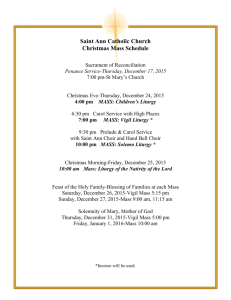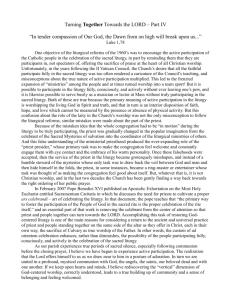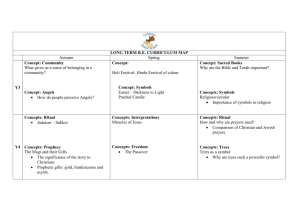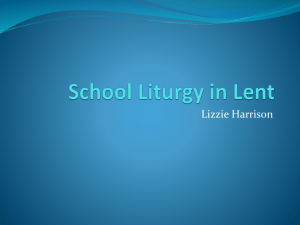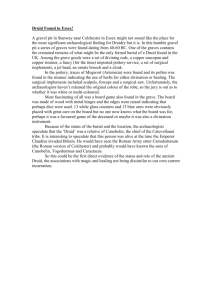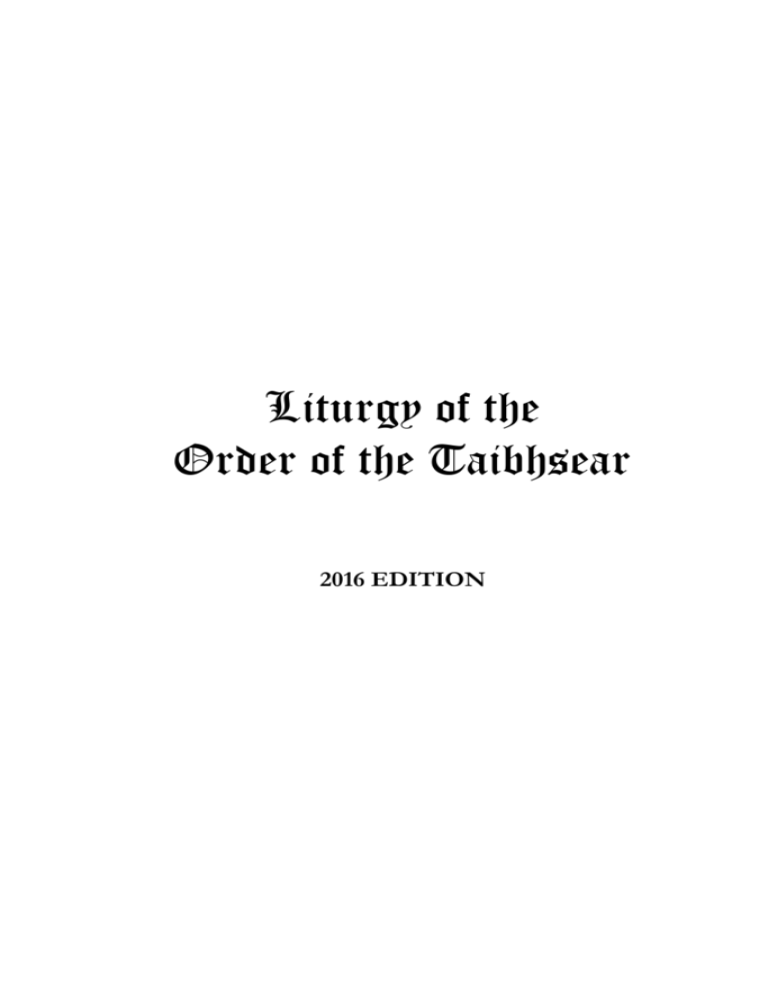
Liturgy of the
Order of the Taibhsear
2016 EDITION
Copyright © 2016 Order of the Taibhsear
All rights reserved.
ISBN:
ISBN-13:
CONTENTS
1 CATECHISM OF THE ORDER OF THE
TAIBHSEAR
1
Liturgy of the Order of the Taibhsear
2
Liturgy of the Order of the Taibhsear
1 CATECHISM OF THE ORDER OF THE TAIBHSEAR
What is the teaching of the Order of the Taibhsear regarding the
nature of The Way of the Taibhsear?
This is a point for consideration, and not a firm doctrine. Consider
this a suggestion for the way things may be, and not an exact description of
the way that things really are:
While tradition, history and reconstruction of the ancient Druid path
are informative and educational to us, the heirs of the tradition, there is a
danger that too strict an observance of tradition could be constrictive to a
living spirituality. Consider that the ancient Druids lived in their own time,
and in their own world, and in their own zeitgeist. This was a time without
electricity, manufactured housing, gasoline-powered engines, or flying
aircraft. It was a time when human sacrifice was acceptable, and wars were
fought hand-to-hand instead of from inside steel and iron machines. Gaelic
and other Celtic languages were common tongues then, not ancient dead
(or near dead) languages. Everything the ancient Druids would have
experienced would be different from what we experience today. If you
doubt that, ask yourself, “When the last time was that I saw a sky that
hadn’t been carved and scarred by a jet contrail, or spent time in the woods
without hearing the distant drone of a mechanical engine?”
Try to picture time as a spiral. As the human race progresses along this
spiral, we return to places we have visited before, but with a higher
awareness and a higher consciousness. Once again, the spiral turns and we
are again seeking spiritual paths more in tune with nature. This time around
the spiral, our higher awareness does not choose the path of human
sacrifice. This time around the spiral, we have modern medicine to
supplement the ancient arts of herbology and healing. This time around the
spiral, we can communicate instantly with other Druids around the globe.
This time around the spiral, The Way of the Taibhsear is not limited to a
select few among the Celtic peoples, but is available to anyone with an
interest. As we progress up the spiral, we gain in knowledge and wisdom.
We cannot go back to the the Way of the Taibhsear of our ancestors, nor
should we. While history, tradition and archaeology can do much to inform
us of the roots of our path, we should not sacrifice The Way of the
Taibhsear on twin altars of history and tradition. A true spiritual path
should be a living, growing and evolving thing. It should be a framework,
rather than a dogma.
We consider the “true The Way of the Taibhsear” to be the way that
the individual feels comfortable with. Historically, druidry is simply the
shamanistic, naturalistic spiritual expression of the Celtic people. The Way
of the Taibhsear today is a living, growing and evolving spiritual path. It is
no longer limited to the Celtic people alone. It now belongs to the entire
world. In the most basic sense, a Druid is simply someone who loves nature
3
Liturgy of the Order of the Taibhsear
and seeks the spiritual experiences to be had in the forests and the
wildernesses. The Way of the Taibhsear is more of a philosophy than a
religion. It is more of a journey than a destination. It is more a way of
perceiving than a way of doing.
Whatever path that may lead to these goals is the “true The Way of the
Taibhsear.” To those who would say that this is not The Way of the
Taibhsear, we would say, “Then tell us what to call it, and we will call it that
instead.”
Our parent Order, the Black Mountain Druid Order, was founded in
2003 by members of Black Mountain Grove. In 2015 it was decided to
change the name of Black Mountain Druid Order to the Order of the
Taibhsear. This is because as our Order grew and evolved, we began to
become vision seekers and seers, and the name “Order of the Taibhsear”
reflects this change in direction. While our roots are in The Way of the
Taibhsear, we have incorporated wisdom from a variety of traditions
throughout the world, and the name change reflects this new direction.
What is the teaching of the Order of the Taibhsear regarding the role
of the clergy?
This is a point for consideration, and not a firm doctrine. Consider
this a suggestion for the way things may be, and not an exact description of
the way that things really are:
On any path, there are always those who are farther along on the
journey than others. There are also those who have walked the path one or
many times before. These individuals can act as guides to those for whom
the path is unfamiliar. Likewise, some parts of the path may more familiar
to one traveler than another, and this traveler can be the guide for that part
of the path. The best guides are those who know when to lead and when to
follow. Those who possess these skills are qualified to be clergy of the
Order of the Taibhsear after undertaking the appropriate training.
In our Order, there are three primary roles filled by trained clergy.
These roles are: Bard, Ovate, and Druid Elder. A brief explanation of each
of these roles follows.
Bard
One who has mastered the songs, poetry and legends of the Celtic
peoples; a poet and/or a musician. In our Order, this training includes
the Mabinogon, the Carmina Gadelica (Pagan Version), and the Cattle Raid
of Cooley. A Bard is also one who is eligible to serve on the Council of
Elders.
Ovate
4
Liturgy of the Order of the Taibhsear
One who has mastered herbology, meditation, holistic healing, and the
healing arts. In our Order, this includes the plants of the Ogham,
Druid energy work and meditation, and holistic living. An Ovate is
also one who is eligible to serve on the Council of Elders.
Druid Elder
One who has mastered the duties of a cleric of the Order of the
Taibhsear, including rites of passage, ritual work, and administrative
duties. The term ‘Druid Elder’ is used for Druids serving in this
clerical capacity in order to distinguish ordained Druid clergy from
other Druids. A Druid Elder is also one who is eligible to serve on the
Council of Elders.
What is the teaching of the Order of the Taibhsear regarding the role
of the individual?
The only requirement for membership in the Order of the Taibhsear is
adherence to the Four Sacred Pillars or our Order. As long as the individual
is on a path that adheres to these principles, the rest of the individual’s path
is his or her own journey. Any spiritual path should be about selfimprovement and not about attempts to improve others; therefore the
Order of the Taibhsear makes no attempts to dictate or enforce any
doctrine or dogma other than the Four Sacred Pillars.
What are the Four Sacred Pillars of the Order of the Taibhsear?
The foundational principles of the Order of the Taibhsear may be
summed up in the Four Sacred Pillars of our Order. These Sacred Pillars
are:
1. Reverence for the Earth and all living things.
2. Respect for diversity and the rights of others.
3. Service to your home Grove, to the Order, and to the larger
community.
4. Personal growth in spirit, mind, emotion, and body.
These Pillars can be summarized as: Reverence, Respect, Service and
Growth.
While we wish to avoid a dogmatic stance about most beliefs, it is
difficult to conceive of a nature-centered path that does not adhere to these
four principles. Because of this, these are the only beliefs we expect of all
members of Order of the Taibhsear, for the following reasons:
It is highly improbable that any nature-centered path could not
have reverence for the Earth and all living things, since the Way of
the Taibhsear is a nature-based philosophical system;
5
Liturgy of the Order of the Taibhsear
It is highly improbable that any spiritual path or system of
philosophy could be a productive means of personal growth if it
did not respect diversity and the rights of others, including the
rights of our plant and animal relatives;
It is highly improbable that a person would want to be part of an
organized spiritual path or philosophical system that did not
function as a community;
It is highly improbable that a person would embark upon a spiritual
path if that person was not interested in spiritual, mental,
emotional and physical growth.
It is for the reasons stated above that the Rite of Initiation into the
Order of the Taibhsear requires allegiance to the principles embodied in the
Four Sacred Pillars.
What are the Nine Druidic Mysteries?
1. Mists of Manannan – Manannan is the Celtic God of the Sea.
Manannan is associated with Avalon, and is the guardian of the
gateway to the Isle of Apples. The Mists of Manannan kept
Avalon hidden from the outside world. Only the elect could pass
beyond the veil of the mists to enter into Avalon. In the Order of
the Taibhsear, the Mists of Manannan represent the veil between
the conscious and the unconscious mind. What others call magic,
we call the tools with which we explore the unconscious.
2. Earth and Sky – humankind lives on the surface of the Earth,
suspended between the realms of Earth below and Sky above. The
Order of the Taibhsear, of course, sees Earth and Sky in the literal
sense, as the environment in which we live. So we are pledged to
take care of our world, but there is also a deeper meaning to Earth
and Sky. In the Order of the Taibhsear, we see the Sky as the
conscious mind, and the Earth as the unconscious mind. These
two halves make up the whole of our experience.
3. The Three Realms – are Land, Sea and Sky. The Three Realms also
speak of the power of triune things. Examples in this since would
be Mother/Maiden/Crone or Warrior/Sage/Golden Child. There are
also triple gods and goddesses. In The Order of the Taibhsear,
some examples of triads would be: Self/Other/Union or
Unconscious/Preconscious/Conscious.
4. The Four Quarters – correspond to the cardinal directions of east,
west, north and south. They also correspond to the four elements:
earth (solid), air (gas), fire (energy) and water (liquid). In The
Order of the Taibhsear, the Four Quarters also represent Mind
(water), Body (earth), Emotion (fire), and Spirit (air). One of the
6
Liturgy of the Order of the Taibhsear
5.
6.
7.
8.
goals of The Way of the Taibhsear is to strike a balance among
these four forces within you.
The Center – this is one of the greatest mysteries of The Way of the
Taibhsear, as it is the one upon which all the others are founded.
Simply put, you are the Center. The Wheel of Taranis is one of the
symbols of the Way of the Taibhsear. Taranis is the Celtic God of
Thunder and Strength, equated with the Norse God Thor. The
Wheel of Taranis consists of a mandala in which the circle is
divided into four quarters, like a Celtic Cross. Each of these four
quarters meets in the center of the circle. Picture this circle as your
mind. Your conscious thoughts move around the rim of the
wheel, but deep in the center, motionless, is your True Self, the
person you were meant to be. The Mystery of the Center lies in
discovering your True Self. This is a lifelong process, and The
Way of the Taibhsear is one of the paths used to make this
journey.
The Sacred Journey – we are all the authors of our own personal
journeys. Another can never write the story for you. As such, we
write our own stories. As travelers writing our own stories, we are
all on a personal, individual journey of self-discovery. the Way of
the Taibhsear is one of the many paths one can take to make this
journey. We should always strive to remember that life itself is a
journey, not a destination. The destination is not as important as
the path we use to arrive. Once we arrive, the story is over, so we
should always take the time to enjoy the journey.
Magic – in the Way of the Taibhsear, magic is the way that we
experience the sacred. We experience magic whenever we have a
sense of awe and beauty within ourselves and the world around us.
In the ancient world, a magus was one who traveled and studied
the ways of the world. Such a person possessed unique knowledge
and experience. In The Order of the Taibhsear, magic is the
means by which we explore the powers of the unconscious mind.
We travel to new places of mind and spirit, to learn their ways.
The rites and rituals of the Order of the Taibhsear allow our
unconscious motivations to break through into the conscious
realm. Our brains take in about 2 billion bits of information per
second, but we are usually only consciously aware of about 4000
of those bits. Magic therefore allows us to tap the resources of the
unconscious mind, bringing these hidden bits into awareness.
The Otherworld – to a spiritualist, the Otherworld would be the
Land of the Dead, or the Summerlands, or Avalon, where the
dead go to await rebirth. In The Order of the Taibhsear, the
Otherworld is what Carl Jung called the Collective Unconscious.
7
Liturgy of the Order of the Taibhsear
In The Order of the Taibhsear, we learn that ultimately we are all
One. From this perspective, the Otherworld is that place where
we reconnect with our Source. That Source is what some have
chosen to call God or Goddess.
9. Immortality – In The Order of the Taibhsear, we believe that the
soul is the only thing in the Universe that is truly indestructible.
Even if you are atheist or agnostic, and have no belief in an
afterlife, this is still true from the point of view of your own
consciousness. If this life is all you will ever know, and there is no
afterlife, then it is impossible to ever be conscious of your own
death; therefore there is no way you could ever know that you
have died. How can you be conscious of your own death, if death
is the end to consciousness? So from the perspective of your own
consciousness, you are immortal for all practical purposes. When
you die, your Universe ceases to exist, and you are no longer the
Center.
These Nine Druidic Mysteries are the foundation for self-awareness.
They lie at the beginning and at the end of the Druidic path in The Order
of the Taibhsear. These mysteries may not be the only way to arrive at
enlightenment, but they may serve as a roadmap to point the way. If you
ever feel yourself beginning to feel lost, then you may return to the
Mysteries until you find your way again.
What are the Seven Spiritual Gifts of The Way of the Taibhsear?
1. The first gift is Unity: of spirit and nature, of individual and
environment, and of individuals to each other.
2. The second gift is Nature: the realization that Nature is not
something separate from ourselves, and the knowledge that we do
not see the world as it is, but that we see the world as we are.
3. The third gift is Healing: rather than treating symptoms, we treat
the whole Person in order to forestall illness and disease. This is
done by promoting a lifestyle that embraces a balance of mind,
body, emotion and spirit in healthy and positive ways.
4. The fourth gift is the Sacred Journey: as we pass the signposts along
the journey of life, our path offers us rites of passage for blessing
and naming of children, passing into adulthood, consecration of
marriage, passage into the Otherworld, and for other occasions
where significant events require a ceremonial rite to mark a
significant passage.
5. The fifth gift is the Otherworld: There are states of consciousness
that exist beyond our ordinary ways of being. The Otherworld
allows us to experience new states of consciousness through the
use of meditation, sweat lodges, dances, music, rituals, and a
8
Liturgy of the Order of the Taibhsear
variety of other techniques in order to learn to grow in body,
mind, emotion and spirit.
6. The sixth gift is Knowledge of the True Self: Each of us possesses an
ideal expression of who we are and who we would like to become.
The gift of Knowledge of the True Self allows us to set forth on
the path of fulfilling our destiny by pursuing our own higher
purpose.
7. The seventh gift is Magic: it teaches us to see the magic in the
world around us and to manifest our best potential in ourselves
and in the world. It also teaches us to revere the mystery that is
life.
What are the Druidic Virtues?
In The Order of the Taibhsear, there are 15 Virtues that guide our
ethical principles. These Virtues are:
1. Trócar – “Mercy:” From tróg (sympathy) and car (friend), literally
friendly to pity. This is the ability to sympathize and empathize with
others.
2. Fíreoin – “Justice:” This is derived from the word for truth, and
means the ability to discern the truth in a situation. This ability then leads
to justice.
3. Cosmail – “Similar, fitting:” The noun is 'cosmailius'. It originally
comes from Old Celtic kom – samalis, which means like for like. In
this sense, it means making the punishment fit the crime. Not in
the eye for an eye sense, but in the sense of not punishing too
harshly. It’s the Druidic equivalent of not engaging in cruel and
unusual punishment.
4. Cuibsech – “Conscientious, scrupulous:” From cubus (modern coibhse,
which means confession, or examination of conscience). It means having
responsibility to self and to others.
5. Fossad – “Steadiness, stability:” Fossad means having a seat under
yourself. This is the quality of not being easily swayed. It means
being steadfast and constant.
6. Eslabra – “Generous, liberal:” The noun is 'eslabrae.’ The Old Celtic
ex slabratobis (out of chains) means knowing no bounds or limits. The
idea is that you shouldn't place limits on your generosity.
7. Gart – “Generosity, hospitality, open-handedness:” Its literal
meaning is warmth and friendliness. This virtue means acceptance and
openness of other people. This is one of the Four Pillars of The
Order of the Taibhsear: Respect for diversity and the rights of
others.
8. Fíalainech - Combination of fíal (faithful, noble) and enech (face, honor).
It means “Politeness; courteous and noble behavior.”
9
Liturgy of the Order of the Taibhsear
9. Sessach – “Sturdy, strong, steadfast:” Someone who stands his
ground and is not easily intimidated.
10. Lessach - "Helpful, beneficent:” The idea here is to seek actively to
help other people, instead of waiting for them to ask.
11. Étir - "Power, ability, competence, skill:” someone who is a true
Renaissance person, skilled in many areas; a person who strives to
excel in everything he/she does.
12. Iondraic – “Honest, trustworthy:” A witness whose testimony can
be believed; of good reputation, someone who is above reproach.
13. Soithnge - "Eloquent,” literally "good with tongue:” This virtue is
important to the Bardic tradition, and refers to the mastery of good
language, skill in poetry, prose and song.
14. Forusta – “Well-grounded, sedate, composed:” literally, established
base. One who is calm and composed at all times; not ruled by
emotions or mood swings.
15. Fírbrethach – “Giving correct judgment:” From fír (ture) and breth,
(judgment); not allowing personal bias to interfere with the
determination of right and wrong.
What is the format of a Rite or Ritual in the Order of the Taibhsear?
There are five basic parts of the observation of a High Day in the Order of
the Taibhsear. These are:
1. Starting the ritual and establishing unity among participants
2. Opening the Gates between the Worlds (opening a path to the
unconscious mind)
3. Calling upon the deities/archetypes of the occasion
4. Using the power received from the deities/archetypes of the
occasion
5. Closing the Gates and ending the ceremony.
Those familiar with Wiccan or Native American Shamanistic beliefs
will notice some familiar elements in the following overview. These Wiccan
and Native American elements have been incorporated into The Order of
the Taibhsear in order to diversify and therefore strengthen our practices.
10
Liturgy of the Order of the Taibhsear
2 FRAMEWORK FOR A RITUAL IN THE
ORDER OF THE TAIBHSEAR
11
Liturgy of the Order of the Taibhsear
12
Liturgy of the Order of the Taibhsear
2 FRAMEWORK FOR A RITUAL IN THE ORDER OF THE
TAIBHSEAR
The following outline is a suggested framework for ritual work in the
Order of the Taibhsear. It is by no means a definitive ritual, but a
suggestion for your own ritual work. As with all things, take what is useful
and leave the rest.
Processional
Many ancient Celtic sites are on a hill or an elevated place. Access to
these places is often arranged so that the sacred space slowly comes into
view as a person walks up the trail. Many modern Druid rituals begin with a
processional to the circle. As the group walks to the sacred space, chants or
songs are often sung. The march to the circle reminds the seeker that he or
she is leaving the world behind and entering into a timeless place. The time
spent walking during the processional should be used to leave the cares of
the world behind and to bring oneself mentally into ritual space.
Purification
Most circles have some sort of gate where attendees enter. This ‘gate’
can be as simple as two stones on the ground, or as elaborate as you wish.
The facilitator of the ritual stands at the outside of the gate, purifying each
attendee before they enter the circle. This can be done by smudging, or by
sprinkling blessed water on the attendee, or by brushing them lightly with
an herb or plant sacred to the occasion, or by simply waving a Bell Branch
over them. Once they have been purified, they are free to enter the circle,
usually in a clockwise (deosil – pronounced ‘jostle’) direction.
Invocation
Here the facilitator briefly states the purpose of the ritual, the
significance of the holiday, and its spiritual meaning. A blessing may be
asked of the God or Goddess associated with the High Day.
Grounding and Centering
After the Invocation, a brief meditative music piece may be played so
that attendees may ground and center themselves, or a brief meditation
guided by the facilitator can achieve the same result.
Grounding is a process by which we cease to rely solely on our own
energy, and instead draw energy from the Earth herself. To ground, picture
yourself as a tree. Roots of energy shoot out from your feet, reaching into
the Earth and drawing energy. Also visualize branches of energy from the
top of your head, like tree branches, reaching up to draw energy from the
sky.
13
Liturgy of the Order of the Taibhsear
Centering involves becoming present in the moment. Ritual space is a
timeless space. Think for a moment about the things that cause you worry
and stress. How many of those things have to do with past events? How
many of those things have to do with events that have not yet happened, or
may not ever happen? Centering is the process of setting aside thoughts and
worries about the past and future. When you center yourself, you let go of
time and step into a timeless place where all things are possible. It is the
process of drawing your attention to nothing but the ritual at hand. Bring all
of your attention to the present moment. When you have done so, you are
centered.
Calling the Quarters
Some Druid traditions call the Quarters, and some do not. If your
Grove chooses to do so, turn and face each direction, starting with the
East, and call upon the Spirits or Guardians associated with each direction.
The facilitator should stand to the North while calling the Quarters. Use the
associations below, if desired, when calling the Quarters. Proceed from the
East in a clockwise direction until all the Quarters have been called:
QUARTER
East
South
West
North
ELEMENT
Air
Fire
Water
Earth
COLOR
Yellow
White
Red
Black
POWER
Birth/Creativity
Transformation
Introspection
Stability/Prosperity
The Blessing of Peace
While calling the Quarters, most Druid traditions include a wish for
peace. This is usually stated while facing each direction, after calling that
particular Quarter. A simple statement such as, ‘May there be peace in the
East,’ should suffice. Be sure to include a peace for all four cardinal
directions. Some traditions include a blessing of peace for the Center by
simply saying, ‘May there be peace in the Center.’
Setting the Center
In many traditions, the Sacred Center consists of the triad of Well,
Fire, and Tree. These can be symbolized by a cup or bowl of water for the
Well, a candle for the Fire (or an open bonfire if the location and occasion
warrant), and a staff for the Tree of Life. The Well and the Fire represent
introspection and transformation, while the Tree of Life represents balance,
uniting Chaos and Order in Middle Earth. The Tree’s roots go deep into
the Earth, drinking the waters of Chaos, while its branches reach into
Heaven, soaking up the rays of the Sun’s life-giving Order.
14
Liturgy of the Order of the Taibhsear
Opening the Gate
Once the Sacred Center has been established, the Gate to the
Otherworld should be opened by calling upon the Gatekeeper. By opening
the Gates to the Otherworld, we allow the wisdom of the Ancestors into
the circle.
Offerings (Sometimes called ‘Sacrifices’)
At this portion of the ritual, a gift of some sort is given to the
Gods/Goddesses of the occasion. This can be a food item tossed into the
Sacred Fire, or a libation poured onto the ground or into a bowl. The idea
behind ‘sacrifice’ instead of ‘offering’ is that you are giving something that
means a great deal to you. This is seen in the spirit of only giving your best
to the Gods and Goddesses. In ancient times, finely-crafted cauldrons,
weapons and such were tossed into rivers as an offering to the Goddess
Danu. The offering should include an acknowledgement of the God or
Goddess for whom the offering is intended, where appropriate.
Blessings and Concerns
At this point, each attendee at the circle is given an opportunity to
express gratitude for any blessings they may have received since the last
circle, or to express a concern or problem that they would like help with.
This can also be a time for a seasonal expression. For example, at Samhain,
members might offer a remembrance of a lost loved one, or at Beltane they
may like to share how they have been blessed by a beloved partner. You
may find it helpful to experiment with variations on this theme, appropriate
to the particular holiday being celebrated. One of the reasons for offering
blessings and concerns is that it builds a stronger Grove by allowing each
member the support of all.
Reading the Omens
This is an optional portion of a Taibhsear ritual. If there is a question
or a concern requiring divination, omens are read by the Celebrant. The
method used is up to the Grove’s personal preferences. Many use rune
sticks or ogham fews. Some use dice, or some just interpret signs given by
Nature herself. I was at a ritual once where a raven landed in the middle of
the circle during the Omens. This was especially significant, since the rite
being celebrated at that time was in honor of the Goddess, the Mórrígan.
The animal most closely associated with the Mórrígan is the raven.
Seasonal Rite
At this portion of the ritual, something specific to the High Day being
celebrated is inserted. For example, you may choose to insert an Ancestor
15
Liturgy of the Order of the Taibhsear
Vigil here for Samhain, or a Hanging of the Bells for Beltane, or a lighting
of the Yule log for Winter Solstice.
Thanksgiving
During this portion of the rite, an offering of thanks to the Gods,
Goddesses, Elementals, etc. is offered. You may also choose to thank any
participants who contributed to the ritual by offering time and/or talents.
At our Alban Elved/Mabon celebrations, we usually go around the circle
and have everyone name at least one thing they are thankful for.
Closing the Gates/Dismissing the Quarters
At this point, call upon the Gatekeeper to seal the way to the
Otherworld. If you have called the Quarters, dismiss them as well. You may
also choose to sing or chant a closing musical offering at this time.
Closing the Rite
At this point, you may sing a final song and make any final
announcements. We usually end with a Recessional in which we leave the
circle through the Gate while singing or chanting. When leaving the circle,
go counter-clockwise, or ‘widdershins,’ around the circle before exiting at
the Gate. When the Recessional has reached a predetermined destination,
you may wish to offer a thanks or statement of dismissal.
The above outline is just a suggested format for those with little or no
experience in crafting rituals. It is by no means a definitive Taibhsear ritual.
The customs and practices of a particular Taibhsear Grove are up to
the members of the circle, as long as they adhere to the Four Sacred Pillars
of our Order.
16
17


